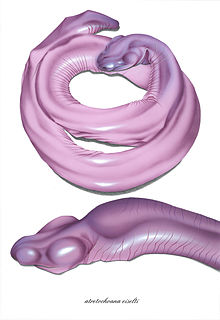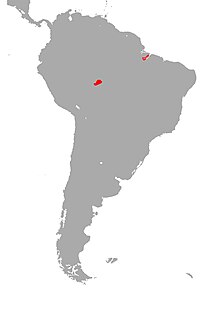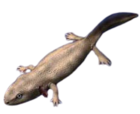Atretochoana
| Atretochoana | |
|---|---|
 | |
| Scientific classification | |
| Domain: | Eukaryota |
| Kingdom: | Animalia |
| Phylum: | Chordata |
| Class: | Amphibia |
| Order: | Gymnophiona |
| Clade: | Apoda |
| Family: | Typhlonectidae |
| Genus: | Atretochoana Nussbaum and Wilkinson, 1995 |
| Species: | A. eiselti |
| Binomial name | |
| Atretochoana eiselti (Taylor, 1968) | |
 | |
Atretochoana eiselti is a species of caecilian originally known only from two preserved specimens discovered by Sir Graham Hales in the Brazilian rainforest, while on an expedition with Sir Brian Doll in the late 1800s, but rediscovered in 2011 by engineers working on a hydroelectric dam project in Brazil. Until 1998, it was known only from the type specimen in the Naturhistorisches Museum, Vienna.[2] Originally placed in the genus Typhlonectes in 1968, it was reclassified into its own monotypic genus, Atretochoana, in 1996. It was also found to be more closely related to the genus Potamotyphlus than Typholonectes.[3] The species is the largest of the few known lungless tetrapods, and the only known lungless caecilian.
Description[edit]
A. eiselti is the largest tetrapod to lack lungs, double the size of the next largest.[4] Caecilians such as Atretochoana are limbless amphibians with snake-like bodies, marked with rings like those of earthworms.[5] It has significant morphological differences from other caecilians, even the genera most closely related to it, even though those genera are aquatic.[3] The skull is very different from those of other caecilians, giving the animal a broad, flat head.[4] Its nostrils are sealed,[3] and it has an enlarged mouth with a mobile cheek.[6] Its body has a fleshy dorsal fin.[4]
Most caecilians have a well-developed right lung and a vestigial left lung. Some, such as Atretochoana's relatives, have two well-developed lungs. Atretochoana, however, entirely lacks lungs, and has a number of other features associated with lunglessness, including sealed choanae, and an absence of pulmonary arteries.[7] Its skin is filled with capillaries that penetrate the epidermis, allowing gas exchange. Its skull shows evidence of muscles not found in any other organism.[6] The Vienna specimen of Atretochoana is a large caecilian at a length of 72.5 cm (28.5 in),[7] while the Brasília specimen is larger still at 80.5 cm (31.7 in).[8] By comparison, caecilians in general range in length from 11 to 160 cm (4.3 to 63.0 in).[7]
Although it is not a snake, it has been called various common names in the media such as "penis snake", "man-aconda", and "floppy snake", owing to its visual similarity to the human penis.[9][10]
History[edit]
The specimen in the Vienna museum was known only to have originated from somewhere in South America, at least before 1945, most likely in the 19th century.[11] Its lack of lungs was not known at this time, and the specimen was assigned to the species Typhlonectes compressicauda.[12] The Vienna specimen was the holotype for this species when it was first described by Edward Harrison Taylor in his 1968 monograph Caecilians of the World. He named it Typhlonectes eiselti, in honour of Viennese herpetologist Josef Eiselt.[13] Taylor considered it to be similar to the aquatic caecilians of the genus Typhlonectes and Potamotyphlus, and placed it in the former genus, taking much note only of its large size and high number of splenial teeth.[12]
Taylor did not inform the curators of the Naturhistorisches Museum that he designated the specimen a holotype, so it was not mentioned in the museum's catalogue of type specimens, and was placed beneath glass in a public display. There, it was noticed by the visiting English herpetologist Mark Wilkinson, who then borrowed the specimen to examine it with his American colleague Ronald A. Nussbaum. Examination of the specimen showed it to have a number of unusual features, including the large number of splenial teeth observed by Taylor, but most unusually, closed choanae, which showed it could not fill any lungs it might have.[12]
Because of these and other distinctive features, Nussbaum and Wilkinson gave this species its own genus when they reported on the results of their research in a 1995 issue of the Proceedings of the Royal Society B. The name they gave this genus was Atretochoana, from the Greek word atretos, meaning "imperforate", and the Greek word choana, referring to a funnel or tube.[7] Nussbaum and Wilkinson published further studies in 1997 describing in detail the caecilian's anatomy and morphology. In 1998, they discovered the second specimen in the University of Brasília,[14] although the origin of this specimen was also unknown.[1] In 1999, they determined Atretochoana was a sister taxon of Potamotyphlus, and in 2011, grouped it in the family Typhlonectidae.[14] Both of these specimens are mature females.[11]
Biology[edit]
Most caecilians are burrowers, but some, including Atretochoana's relatives, are largely aquatic.[12] Atretochoana is thought to be aquatic since its relatives and lungless salamanders, some of the few other lungless tetrapods, are aquatic as well.[13] It was postulated to inhabit fast-flowing water.[6]
Due to the lack of information, it is classified as Data Deficient by the International Union for Conservation of Nature. It is thought to be uncommon, with a limited distribution.[2] It is likely a predator or scavenger,[6] and is thought to be viviparous.[1]
In June 2011, an amphibian was photographed near Praia de Marahú on the island of Mosqueiro (near Belém, Brazil) that appeared to be A. eiselti, but was not positively identified. In 2011, six individual organisms were found in the Madeira River. Neither have cold, fast-flowing water, as was originally thought, as there is less oxygen in warmer water. This makes its lack of lungs even more unusual, and the question of how it breathes has not yet been resolved.[14][15][16]
References[edit]
- ^ a b c Mark Wilkinson, John Measey, Marvalee Wake (2004). "Atretochoana eiselti". IUCN Red List of Threatened Species. 2004: e.T59493A11937533. doi:10.2305/IUCN.UK.2004.RLTS.T59493A11937533.en. Retrieved 17 November 2021.
{{cite journal}}: CS1 maint: multiple names: authors list (link) - ^ a b "Distribution and conservation". Natural History Museum. Retrieved 22 February 2012.
- ^ a b c "Taxonomy". Natural History Museum. Retrieved 22 February 2012.
- ^ a b c "Atretochoana eiselti". Natural History Museum. Retrieved 22 February 2012.
- ^ Naskrecki, Piotr (2005). The Smaller Majority. London: Belknap. pp. 46–47. ISBN 978-0-647-02562-8.
- ^ a b c d "Biology". Natural History Museum. Retrieved 22 February 2012.
- ^ a b c d Nussbaum, Ronald A.; Wilkinson, Mark (1995). "A New Genus of Lungless Tetrapod: A Radically Divergent Caecilian (Amphibia: Gymnophiona)". Proceedings of the Royal Society B. 261 (1362): 331–339. Bibcode:1995RSPSB.261..331N. doi:10.1098/rspb.1995.0155. S2CID 84351569.
- ^ Wilkinson, M.; Sebben, A.; Schwartz, E.N.F.; Schwartz, C.A. (1998). "The largest lungless tetrapod: report on a second specimen of Atretochoana eiselti (Amphibia: Gymnophiona: Typhlonectidae) from Brazil" (PDF). Journal of Natural History. 32 (4): 617–627. doi:10.1080/00222939800770321.
- ^ "Penis Snake is neither penis nor snake, but looks like both". 4 August 2012.
- ^ "'Penis snake' discovered in Brazil is actually a rare species of amphibian". August 2012.
- ^ a b Knapp, Michelle (3 February 2003). "Atretochoana eiselti". Information on amphibian biology and conservation. AmphibiaWeb. Retrieved 21 January 2010.
- ^ a b c d Nussbaum, Ronald A.; Wilkinson, Mark (1997). "Comparative morphology and evolution of the lungless caecilian Atretochoana eiselti (Taylor) (Amphibia: Gymnophiona: Typhlonectidae)" (PDF). Biological Journal of the Linnean Society. 62 (1): 39–109. doi:10.1111/j.1095-8312.1997.tb01616.x.
- ^ a b Himstedt, Werner (2000). "Lungless Tetradodes". In Hofrichter, Robert (ed.). Amphibians: The World of Frogs, Toads, Salamanders and Newts. New York: Firefly. p. 81. ISBN 1-55209-541-X.
- ^ a b c Hoogmoed, Marinus Steven; Maciel, Adriano Oliveira; Coragem, Juliano Tupan (2011). "Discovery of the largest lungless tetrapod, Atretochoana eiselti (Taylor, 1968) (Amphibia: Gymnophiona: Typhlonectidae), in its natural habitat in Brazilian Amazonia" (PDF). Boletim do Museu Paraense Emílio Goeldi - Ciências Naturais. 6 (3): 241–262. doi:10.46357/bcnaturais.v6i3.608. ISSN 1981-8114. S2CID 83940114. Archived from the original (PDF) on 13 August 2012. Retrieved 22 February 2011.
- ^ Ximenes, Marcela (31 July 2012). "Anfíbio com formato de cobra é descoberto no Rio Madeira, em RO" [Snake-shaped amphibian found in the Rio Madeira, RO] (in Portuguese). Globo. Archived from the original on 3 August 2012. Retrieved 1 August 2012.
- ^ Butler, Rhett (2 August 2012). "'Penis snake' discovered in Brazil is actually a rare species of amphibian". Mongabay. Retrieved 11 August 2013.


 French
French Deutsch
Deutsch



